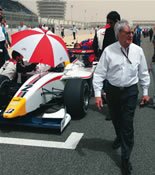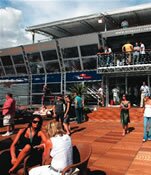Inflight Magazine of Brussels Airlines
Welcome to the Inflight Magazine of Brussels Airlines
MOTORING
Terrific Tribeca is talk of the town
 Subaru’s mighty B9 Tribeca makes long motorway journeys a breeze – and comes at a more competitive price than some of its high-profile rivals in the luxury 4×4 sector
Subaru’s mighty B9 Tribeca makes long motorway journeys a breeze – and comes at a more competitive price than some of its high-profile rivals in the luxury 4×4 sector
Regular visitors to New York will know there is an upmarket residential zone called Tribeca. It is also the name given by Subaru to its latest challenger on the 4×4 front, which echoes the same distinctive appeal as its iconic uptown namesake.
The company is anxious to point out that the B9 Tribeca is not a volume seller, certainly not in Europe, and particularly not in Belgium, where only 15 have been sold since its launch for the luxury sector last October.
As they prepare to hit the UK market in November, Subaru have promised that the five- or seven-seater will undercut the price levels of its long-established rivals the Porsche Cayenne, Volvo XC90 and BMW X5.
 Not only that, say Subaru, the quality and luxury of the Tribeca makes it ideal for the biggest families to take the discomfort out of arduous motorway journeys.
Not only that, say Subaru, the quality and luxury of the Tribeca makes it ideal for the biggest families to take the discomfort out of arduous motorway journeys.
It has a mighty engine in the 3.0-litre SE5, and it scored five stars in America’s National Highways Traffic Safety Administration tests on side and front crash protection.
Against it, at least as far as Belgium is concerned, is the high tax penalty on the 3.0-litre engines, and its heavy fuel thirst, but from its sheer roominess and all-round feel of five-star luxury, the Tribeca should prove to be a winner.
It has a three-tier price tag – the ‘Comfort’ five-seater model is €43,200, the ‘Luxury’ is €48,200 and the flagship seven-seater ‘Executive’ is €51,200.
And to add to its appeal, the price includes three years’ membership of Subaru Assistance – valid for both the UK and Europe – which guarantees owners a comprehensive roadside and recovery deal.
Melbourne lights up
 Will the Australian GP be scrapped after Bernie Ecclestone’s demands that organisers run it at night to allow European TV viewers to watch the action at a reasonable hour?
Will the Australian GP be scrapped after Bernie Ecclestone’s demands that organisers run it at night to allow European TV viewers to watch the action at a reasonable hour?
Formula One supremo Bernie Ecclestone wants the Australian GP in Melbourne to be staged at night so that European TV viewers won’t miss out on the live action that is currently beamed early morning to the Continent.
If the organisers do not comply with Ecclestone’s plan, they will not have their contract renewed when it expires in 2010.
Ecclestone says: “Unless the organisers come up with a satisfactory plan, we will not be able to continue with the race there.
“I would like to ensure that the millions of TV viewers in Europe and other parts of the world may watch it live at a respectable time rather than having to get up at three or four o’clock in the morning.”
Sources in Melbourne suggest Ecclestone’s idea is unworkable. The cost of lighting the circuit and its surroundings, allied to the problems associated with running a night race on a Sunday evening within an inner-city residential zone, suggests the plan is a non-starter.
And that could spell the end of the Australian GP – a popular event with both teams and spectators since it joined the championship in 1985.
Restaurant Red Bull
 One of the most amazing sights at the Monaco Grand Prix was Red Bull’s floating hospitality unit, the so-called ‘Energy Station’, towering alongside the paddock.
One of the most amazing sights at the Monaco Grand Prix was Red Bull’s floating hospitality unit, the so-called ‘Energy Station’, towering alongside the paddock.
When they found there wasn’t room on the jam-packed jetty, Red Bull had the three-storey-plus-swimming-pool unit built on the water in Imperia, Italy, and towed by tugs to Monaco Harbour.
Every day it catered for around 800 people, with some 2,000 meals (with champagne and fine wines) served over the race weekend by 11 top-class chefs.
When the 32mx14m central unit is dismantled and used at other European GPs it takes 22 freight trucks to deliver it and 30 men to erect it in two-anda-half days. For back-to-back races 45 people set it up in a single day.
Leave a Reply
